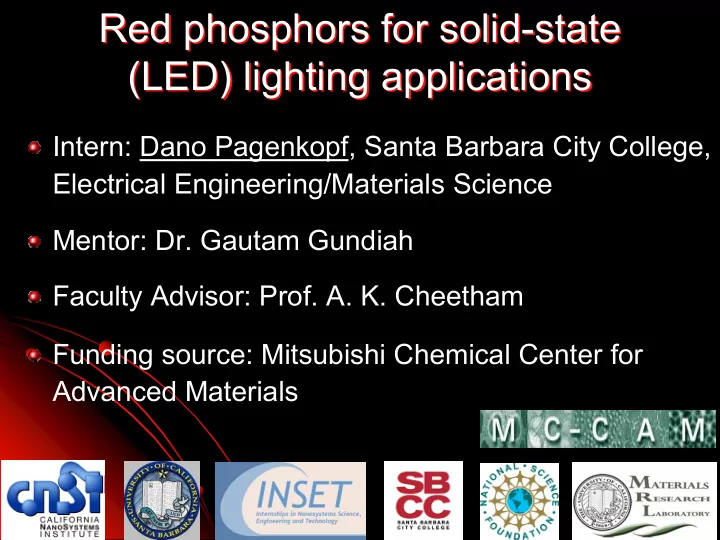

Red phosphors for solid- -state state Red phosphors for solid (LED) lighting applications (LED) lighting applications Intern: Dano Pagenkopf, Santa Barbara City College, Electrical Engineering/Materials Science Mentor: Dr. Gautam Gundiah Faculty Advisor: Prof. A. K. Cheetham Funding source: Mitsubishi Chemical Center for Advanced Materials
Introduction Introduction Solid state lighting (LEDs) use about an eighth of the energy that incandescent bulbs use, have a lifespan of over 50,000 hours and do not contain the mercury found in fluorescent bulbs. This translates to a 5+ year lifespan and energy savings of over 85% for lighting. Applications of LEDs: www.lumileds.com www.alt-e.blogspot.com www.lumileds.com www.lumileds.com
Research objectives Research objectives A phosphor is a solid/powder that can absorb radiation of one wavelength and convert it to light of another color. www.physics.utoledo.edu www.phosphortech.com
Our current LEDs have a blue chip (460 nm) that excites a yellow phosphor, emitting a white light. The next generation of LEDs will use an ultraviolet chip (400 nm) that will excite red, green and blue phosphors. www.toyoda-gosei.com
Research objectives… …continued continued Research objectives Commercial red phosphor- Yttrium oxysulfide Y 2 O 2 S:Eu Excitation wavelength 340 nm, emission wavelength 627 nm Can addition of Bi 3+ shift Can we tune the excitation to a longer particle size by wavelength? use of salt flux?
Experimental Experimental Y(NO 3 ) 3 Eu(NO 3 ) 3 Bi(NO 3 ) 3 D.I. H 2 O Procedure Procedure Stir & add NH 4 OH to Raise pH to 10 Y 2 O 3 :Bi,Eu 600 0 C Centrifuge Vacuum White ppt Verified by & wash 10 h, dry XRD & PL air Wash with Add 900 0 C Y 2 O 2 S:Bi,Eu Hot D.I. H 2 O, Y 2 O 2 S:Bi,Eu Na 2 S 2 O 3 Verified by 12 h Then 1.5 M HCl & salt flux XRD & PL N 2 S.E.M.
Equipment used Equipment used Tube furnace (up to 1200 o C) Gold sputtering (for SEM) Scanning electron microscope (SEM)
Characterization – – X X- -ray diffraction ray diffraction Characterization To find out if the sample synthesized was pure Mainly pure Y 2 O 2 S (compared to standard) Impurity of Y 2 O 3 (~30%) * * * * XRD pattern of Y 2 O 2 S:Eu(5%) without salt flux.
Characterization – – Scanning Electron Microscopy (SEM) Scanning Electron Microscopy (SEM) Characterization To find out the morphology DP-2 DP-4 Reactant Y 2 O 3 Product Y 2 O 2 S (no salt flux) Products look totally different from reactants. Product contains particles having a size between 200-1000 nm.
Characterization – – Photoluminescence Spectroscopy Photoluminescence Spectroscopy Characterization To measure luminescence (determine excitation and emission) 3+ (5%) Photoluminescence spectrum of DP-4 - Y 2 O 2 S:Eu Broad excitation with 700 Photograph on UV excitation λ em =626nm maximum at 330 nm. 600 500 Line emission with Intensity (a.u.) 400 maximum at 626 nm. 300 Excitation Emission 200 λ ex =365nm 100 0 250 300 350 400 450 500 550 600 650 700 Wavelength (nm) 600 400 500 700
Effect of salt- -flux addition flux addition Effect of salt No salt flux 2.8 moles of Na 2 HPO 4 Particle size 100-400 nm Particle size 200-1000 nm Slightly elongated rods present Further characterization under progress
Effects of adding different salt- -fluxes fluxes Effects of adding different salt 5 mol Na 2 HPO 4 2.5 mol NaCl 2.5 mol NH 4 Cl Further characterization under progress
Summary Summary Optimized the synthesis of Y 2 O 2 S phosphor. Addition of salt-fluxes such as Na 2 HPO 4 , KCl, NaCl, NH 4 Cl was studied. Bi 3+ doping did not shift the excitation of Y 2 O 2 S:Eu. Learned the use of different instruments such as centrifuges, furnaces, ovens etc. to synthesize the samples and XRD, PL, SEM to characterize them. Future Plans Future Plans Optimize the flux and reaction conditions to obtain uniform morphology. Perform optical studies on the samples.
Acknowledgements Acknowledgements Dr. Nick Arnold Samantha Freeman Liu-Yen Kramer Prof. Evelyn Hu Lad Handelman, Linda Seals Lady & Blossom Hanna Pagenkopf The Cheetham Group Dr. Leah Appelhans Dr. Francois Chevire INSET colleagues
Thank You, Thank You, Questions? Questions?
Recommend
More recommend